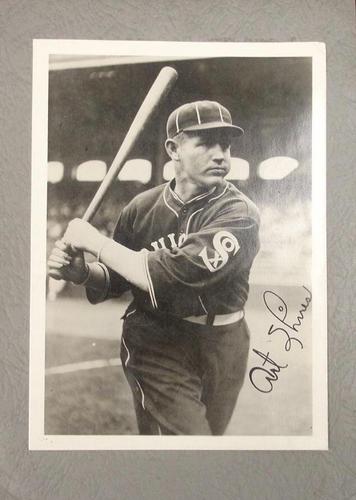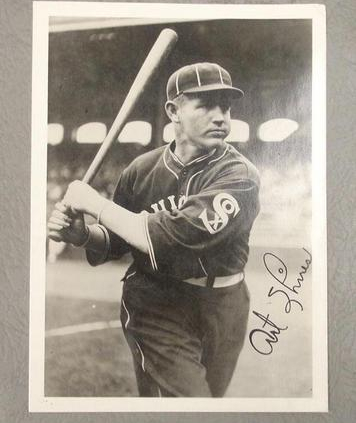August 20, 1928: Art Shires raps out 4 hits in big-league debut with White Sox
 Few rookies ever made a bigger splash in their debut than Chicago White Sox first baseman Art Shires.1 Most of the fanfare came from Shires, who nicknamed himself “The Great” and was also known by the sobriquet “Whataman.” The native of Italy, Texas, starred for Waco of the Class A Texas League, where he batted .309 over two seasons before the White Sox acquired his contract on July 31, 1928.
Few rookies ever made a bigger splash in their debut than Chicago White Sox first baseman Art Shires.1 Most of the fanfare came from Shires, who nicknamed himself “The Great” and was also known by the sobriquet “Whataman.” The native of Italy, Texas, starred for Waco of the Class A Texas League, where he batted .309 over two seasons before the White Sox acquired his contract on July 31, 1928.
Though Shires was unhappy about the deal – he insisted that Waco had received a better offer from the Cleveland Indians that would have given him a “liberal cut” of the purchase price2 – he eventually reported to the White Sox in mid-August. On August 20 the Chicago Tribune announced that Shires, “the first basing sensation of the minors,” would make his debut against the Boston Red Sox at Fenway Park. “Bud Clancy has played every inning of every game and will start on a rest if Shires seems all he’s cracked up to be,” wrote the Tribune.3
Despite having added talented players like third baseman Willie Kamm, center fielder Johnny Mostil, left fielder Bibb Falk, outfielder Alex Metzler, and pitchers Tommy Thomas and Ted Lyons after the Black Sox Scandal gutted the core of the roster in the last week of the 1920 season, the White Sox had been unable to finish better than fifth in an eight-team league since 1921. First base hadn’t been an issue for the White Sox since Earl Sheely became the starter in ’21. Sheely was a productive hitter who batted .305 in seven years with Chicago while regularly driving in at least 80 runs, something he did six times. But he suffered through a poor 1927 campaign and lost his job to Clancy.
On August 20, the soon-to-be 28-year-old Clancy was batting .270 with only 2 homers and 35 runs batted in for a White Sox team that sat in fifth place with a record of 53-64-1 and a 26½-game deficit in the standings. The New York Yankees (80-38) and Philadelphia Athletics (74-42) were making a mockery of the American League pennant race and finished first and second respectively in home runs and runs scored. The anemic White Sox finished the season with only 24 homers, 30 fewer than Yankees slugger Babe Ruth hit by himself, and were trying to hold on to fifth place for the fourth straight season.
Much like the Black Sox Scandal had decimated the White Sox, the Red Sox owner Harry Frazee’s demolition of a Boston roster that had copped a World Series title in 1918 sent the team into a tailspin from which they wouldn’t recover until 1935, when they finished above .500 for the first time in 17 years. In one year alone, from December 1918 to December 1919, Frazee traded or sold 17 players, including starting pitchers Dutch Leonard, Ernie Shore, and Carl Mays, outfielders Duffy Lewis and Amos Strunk, second baseman Jack Barry, and, of course, Ruth.
From 1922 to 1927, the Red Sox finished last in the AL five times and were on their way to a sixth last-place finish in seven seasons in 1928, burdened by a 43-73 record on August 19 with a 36-game deficit behind the front-running Yankees.4 The Red Sox had climbed as high as fourth place in mid-May and were in fifth as late as July 3 before the wheels fell off. A doubleheader sweep at the hands of the Yankees on June 30 had sent the Red Sox into a tailspin that found them scoring only 3.4 runs a game and allowing 5.7 over their next 55 games, easily the worst marks in the junior circuit.5
The August 20 game, a Monday afternoon tilt played in front of only 3,300 fans, pitted two future Hall of Fame pitchers against each other – Red Faber for the White Sox and Red Ruffing for the Red Sox. Shires, a week past his 22nd birthday, batted second behind former AL stolen-base champ Mostil, and ahead of Metzler, one of the team’s best hitters.
Mostil led off the game with a groundout, but Shires followed with a triple to the flagpole in center field, described by sportswriter Edward Burns as a “mighty swat that went to the farthest [part of the park],” then scored on a single by Metzler to give Chicago an early 1-0 lead.6 The White Sox increased their lead to 2-0 in the second inning, when Shires got his first major-league RBI with a single that followed a base hit by Buck Crouse and a sacrifice by Faber.
Shires missed out on a golden opportunity to drive in more runs in the third when “terribly dizzy” baserunning by his teammates killed what should have been a big inning.7 Falk began the rally with a leadoff double to right, then landed on third on consecutive walks to Kamm and Karl Swanson that loaded the bases. Buck Redfern hit what should have been an easy double-play ball, but shortstop Billy Rogell muffed the pivot and Falk scored.
Crouse scored Kamm with a single, but Swanson and Redfern ran the team into an out. “Swanson and Redfern became confused on the baseline between second and third,” wrote Burns. “The windup of the spectacle was the tagging out of Swanson between third and home.”8 Faber fanned and Mostil fouled out to right to end the threat and the inning. Instead of a big inning, Chicago plated only two runs and the final out was made with Shires on deck.
The White Sox’ edge proved to be temporary when Boston plated four tallies in the bottom of the inning to knot the game at 4-4. Faber retired Fred Hofmann to begin the inning, but walked Ruffing and surrendered a single to Jack Rothrock, who advanced to second on the throw to third. With runners at second and third and one out, Rogell atoned for his earlier miscue by knocking in both runners with a single. Faber retired Buddy Myer on a grounder back to the box but walked Bill Regan and gave up a three-bagger to Ira Flagstead that tied the game.
Then both hurlers settled down for a while. “After the third both clubs were as tame as pussycats until the seventh,” wrote Burns.9 Shires was retired on a failed bunt attempt in the fourth but rapped out a single in the top of the sixth. He and the White Sox weren’t through, though. Metzler singled to lead off the top of the seventh, advanced to third on a single by Falk, and came plateward on Kamm’s fly to right to give the White Sox a 5-4 lead.
Faber continued to keep the Red Sox at bay, although not without some tightrope walking, as he loaded the bases with one out in the seventh thanks to Ruffing’s double, a walk to Rothrock, and an error by shortstop Redfern. But he coaxed Myer to ground into a force out at the plate and fanned Regan to end the threat.
Ruffing remained in the game and was touched for a sixth run in the top of the ninth when Shires rapped out his third single of the game, moved to third on Falk’s third hit, and scored his second run on another sacrifice fly by Kamm to give the White Sox a 6-4 lead that Faber maintained for the win.
James O’Leary of the Boston Globe was especially impressed with Shires, writing that the “raw recruit just about beat Charley Ruffing single handed” after he “seeped into town from Waco, Tex yesterday morning.”10
“He has been hitting hard all season in the Texas League,” O’Leary wrote, “and has all the earmarks of a splendid prospect. … That boy Shires loomed up big.”11 Burns agreed. “[Shires’] carryings on were no small factor in the White Sox victory over the Red Sox, which was accomplished by a score of 6-4,” he wrote.12
Of course, no one was more impressed with Shires’ performance than Shires himself. So cocky was the 21-year-old that he boasted after the game, “So this is the great American League I’ve heard so much about? I’ll hit .400!”13 He didn’t hit .400 but batted .341 in 33 games and immediately challenged Carl Reynolds as the team’s best hitter. Alas, the White Sox finished in fifth place and wouldn’t finish a season with a winning record until 1936. It wasn’t until 1959 that they’d win another pennant.
Shires batted .291 in a tumultuous four-season major-league career that saw him battle alcoholism and White Sox manager Lena Blackburne, whom Shires assaulted on multiple occasions.14 Shires was out of the majors at 25 after a serious knee injury derailed his career in 1932. He continued to play in the minors until 1935.
Acknowledgments
This article was fact-checked by Mike Huber and copy-edited by Len Levin.
Sources
In addition to the sources cited in the Notes, the author accessed Baseball-Reference.com and Retrosheet.org for pertinent information, including the box score and play-by-play.
https://www.baseball-reference.com/boxes/BOS/BOS192808200.shtml
http://www.retrosheet.org/boxesetc/1928/B08200BOS1928.htm
Notes
1 The previous player to have four hits in his major-league debut was Casey Stengel of the Brooklyn Dodgers, who recorded four singles against the Pittsburgh Pirates on September 17, 1912. The only player to have five hits in his major-league debut between 1901 and 2023 was Cecil Travis of the Washington Nationals, who singled five times in seven at-bats against the Cleveland Indians on May 16, 1933. (The game went 12 innings.) Nobody has done it in a nine-inning game.
2 “Waco Star Balks at Sale to White Sox,” Chicago Tribune, August 3, 1928: 21.
3 “Sox League of Youth to Face Boston Today,” Chicago Tribune, August 20, 1928: 25.
4 From 1922 to 1932, the Red Sox finished last nine times before finishing seventh in an eight-team league in 1933. They didn’t finish last again until 1992, when they came in seventh in the American League East Division.
5 Of Boston’s 10 primary batters, only four – Buddy Myer, Fred Hofmann, Billy Rogell, and Jack Rothrock – didn’t suffer a drop in offense from June 28 to August 19, but Myer was the only regular while the others were utility players. Of the seven pitchers who threw the most innings, only Red Ruffing and Merle Settlemire had better ERAs from June 28 to August 19, but Ruffing went 2-9 thanks in part to five one-run losses.
6 Edward Burns, “Rookie Shires Leads Sox to 6-4 Win Over Boston,” Chicago Tribune, August 21, 1928: 15.
7 Burns, “Rookie Shires Leads Sox to 6-4 Win Over Boston.”
8 “Rookie Shires Leads Sox to 6-4 Win Over Boston.”
9 “Rookie Shires Leads Sox to 6-4 Win Over Boston,”
10 James O’Leary, “Shires of Waco Busts Into Big Show to Sorrow of Red Sox,” Boston Globe, August 21, 1928: 22.
11 “Shires of Waco Busts Into Big Show to Sorrow of Red Sox.”
12 Burns.
13 “Art (What-a-Man) Shires Dies,” Kansas City Times, July 14, 1967: 24.
14 Mike Lynch, “Art Shires,” SABR BioProject, accessed online on November 20, 2023.
Additional Stats
Chicago White Sox 6
Boston Red Sox 4
Fenway Park
Boston, MA
Box Score + PBP:
Corrections? Additions?
If you can help us improve this game story, contact us.


